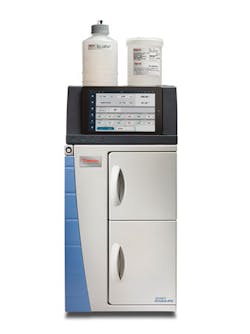Innovating Water Analysis Instrumentation for Regulatory Monitoring
By Terri Christinson
How safe is your drinking water? For most industrial countries, drinking water is very safe due to the efforts of municipal water agencies. Using the latest analytical techniques, these agencies work hard to ensure that our drinking water is clean and safe, and that the wastewater discharges which can impact drinking water quality are in compliance.
In the US, drinking water quality is legislated through the Safe Drinking Water Act (SDWA) to ensure the integrity and safety of drinking water. Wastewater is managed through the Clean Water Act (CWA) as part of the wastewater permitting process to reduce the discharge of pollutants into waters. Inorganic anions are monitored as part of the SDWA requirements: primary contaminants that can impact health or environment, such as fluoride, nitrate, nitrite, and disinfection byproducts, and secondary contaminants that may impact aesthetic qualities (taste, color, and odor), such as chloride and sulfate. Many of these same inorganic anions are also regulated through the CWA industrial permitting process.
Municipal water agencies commonly use ion chromatography (IC) to determine the inorganic anion concentrations. Since 1975, when Dionex (now part of Thermo Fisher Scientific) invented IC, chemists have replaced their colorimetric titration methods with IC. Since the first IC regulatory method was developed in the 1980s with the US EPA (EPA Method 300.0 (A) (B)), the company has continued to actively developed new methods with regulatory and municipal water agencies to advance the analytical capabilities of IC. IC is a now well-established and accepted technique for inorganic anion determinations in water, including drinking water. Over the last 40 years, Thermo Fisher continues to innovate and advance IC technology in ion chromatography systems, columns, consumables and data analysis systems.
The latest IC system innovation, the Thermo Scientific™ Dionex™ Integrion™ RFIC™ HPIC™ I, is designed for routine analysis by analysts of all experience levels. System innovations include high pressure capabilities for Reagent-Free™ IC (RFIC) (up to 5000 psi), column heater control and many new features designed to make IC easy, including: flexibility for any IC application, completely upgradable with flexible system configurations; faster equilibration and easy access with separate compartments for pump, column heater with injection valve, and detection-suppressor; easy-to-install, low void volume Thermo Scientific™ Dionex™ IC PEEK Viper™ fittings to improve chromatography and ensure accurate reporting; consumables device monitoring for regulatory compliance tracking, which also reduces the likelihood of an improper set-up; independent tablet control for convenient, continuous full-screen monitoring, independent manual control, and the online instrument manual and troubleshooting guides; and new Thermo Scientific™ Dionex™ Chromeleon™ 7 Chromatography Data System (CDS) software features that provide easy electronic configuration, monitoring of consumable devices, and online video instructions.
For more information, visit www.thermofisher.com.
About the Author: Terri Christison is currently an Applications Chemist, Marketing Specialist in Ion Chromatography (IC) at Thermo Fisher Scientific with more than 15 years’ experience in ion chromatography and other separation methods. She develops and promotes IC and IC-MS analytical methods to provide solutions to customers’ analytical problems. Terri received B.A.s in chemistry and biology from California State University in Fresno, CA with recent publications in Anal. Chem. and J. of Chromatography journals.

